Pleasanton: The Masters of Double Racing
Wednesday, February 11th, 2015
What the Masters is to golf, Pleasanton is to Double Racing, and at the third annual Pleasanton Double Racing® Festival in Pleasanton, Calif., last December 21, Kenya’s Risper Gesawba met her objective – in her own words! – of mastering the Double
By David Prokop
Pleasanton, Calif., may be a quiet, relaxed community across the bay from San Francisco, but where Double Racing® is concerned, this is where all the excitement started, where Double Racing® officially made its debut – on Dec. 23, 2012.
Like the Masters tournament in golf, Pleasanton is the Double Racing® event steeped in the most tradition. The sport not only started here, but this is where the course is so fast, flat and smooth, with interesting twists and turns, it fairly invites competitors of all abilities to shoot for their best times. This is the place where more world records in the Double 15K (10K + 5k), the signature event in the sport, have been set than anywhere else. This is where the greatest number of competitors each year turn out for the Double. This is Ground Zero of Double Racing®, the place from which everything else in the sport has sprung and come to fruition.
Read more...
Comments and Feedback
 Lots of PR's at the 3rd Annual Pleasanton Double Road Race. World record times! Fast fun course! Mark your calendar Dec 20, 2015. Bob Anderson 2/12/15 9:03 am
Champions of the Double
Monday, September 15th, 2014
A conversation with Peter Mullin
Peter Mullin has taken Double Racing® by storm. He broke the 60-64 age group world record in the first Double 15K he ever ran – the second annual Pleasanton Double last December. While he didn’t improve on that time in his next two Doubles – runners had to contend with heavy winds in Fort Lauderdale, Fla., and the course in Overland Park, Kan., had some hills – he won the prestigious Double Victory Cup for best age-graded performance in each of those races. As a result of this impressive three-for-three debut in Double Racing®, he went straight to the top of the Men’s Leader Board for the Double 15K.
None of this should come as any surprise really. Before he ever ran a Double, the 5’9”, 152-pound oil exploration engineer from Houston, Tex., had established himself as one of the nation’s top Masters runners and in 2012 he was named the Ujena Fit Club Runner of the Year.
Read more...
Comments and Feedback
 Good luck Peter this weekend at the San Juan Bautista Double 15k. Going to be competitive. See you soon! Bob Anderson 9/15/14 10:00 am
Racing the Double - an Outsider's View
Monday, March 24th, 2014
Another approach to racing the Double Road Race
By Rich Stiller
I have never raced The Double Road Race.
I have headed up the course monitors at two of The Double Road Race events so I have seen the race up close without actually having stepped on the course with a race number. I have raced other doubles but that was years ago, back in the 1990’s, as the running member of a two-man duathlon team. Back then I was paired with a cyclist. I ran 5K, waited around while the cyclist did his 25-30K leg and then I ran another 5K leg.
Read more...
Comments and Feedback
 Rich Stiller's approach to racing the Double. I am not sure if I can run the 10k leg without running all out! But that's just me. I always run my 5k leg at the same or faster pace. My best Double is 1:05:03. I ran 43:25 for the 10k leg (6:59 pace) and 21:38 for the 5k leg...just a little faster. But there is no right or wrong way to race the Double. The best way is what works for you! Thanks for sharing your thoughts Rich... Bob Anderson 3/24/14 3:51 pm
DO YOU DOUBLE?
Monday, January 13th, 2014
The new kid on the road-racing block, the Double Road Race is making a big impact on the American running scene.
By David Prokop (Editor, Best Road Races)
It is Sunday morning, Dec. 22, 2013 in the attractive San Francisco Bay area community of Pleasanton, Calif. Runners from near and far have gathered for the second annual Pleasanton Double Road Race™, a unique new running competition which made its world debut almost exactly a year earlier at this very site.
The one who has come the farthest to be here is Julius Koskei, a 31-year-old, have-shoes, will-travel professional distance runner from Nyaharuru, Kenya who holds the world record in the Double Road Race™. He makes his living doing this – running! – and a pretty darn good one, which means he’s rather good at it. You try to earn a living and support a family of four off the prize money you win at road races! Or would a desk job somewhere seem a little easier and more appealing?
Read more...
Comments and Feedback
 All Double runners need to read this article by David Prokop...San Jose Double is coming up Feb 22! Bob Anderson 1/13/14 4:07 pm
The Second Annual DOUBLE!
Saturday, December 14th, 2013
The Double Road Race returns to Pleasanton this coming Sunday, Dec. 22 as an established event on the American running scene.
by David Prokop (Best Road Races editor)
It also takes its rightful place as one of the Bay Area’s premier holiday athletic outings – a festive family fun event and world-class competition all rolled into one! In addition to the Double Road Race™, the race program will also feature a Christmas 5K Run & Walk and the Bob Anderson’s Kids’ Cup One-Mile for youngsters 13 and under.
A race run in two segments – as Bob Anderson, who conceived and created the event, says, “It’s the only race with a halftime” – the Double is an innovative new running competition that has been called the next dimension in racing. Competitors run a 10K, followed by a concluding 5K which starts one hour and 45 minutes after the 10K goes off the line. Final placings are determined on the basis of combined or aggregate time.
Read more...
Comments and Feedback
 The stage is set, the weather forecast is good and more than 1000 runners will be joining us Double Weekend in Pleasanton Dec 20-22! Bob Anderson 12/14/13 6:05 pm  It will no doubt be your BEST second annual! John Hofacre 12/16/13 10:28 pm
Best Double Yet!
Saturday, August 24th, 2013
Liudmila Stepanova, Christine Kennedy, Malcolm Richards and a 16-year-old runner to watch named Jose Pina Jr. shine at the San Jose Double
by David Prokop
The Double Road Race™ returned to the San Francisco Bay Area today where it was born less than eight months ago, and the San Jose Double proved to be – in many ways – the best Double staged thus far!
The competition was outstanding – with Russia’s Liudmila Stepanova looking totally dominant in the women’s race, although she didn’t improve on her world record as she had originally planned, Christine Kennedy winning the Double Victory Cup (as usual) for best age-graded performance, Malcolm Richards coming out on top in a very competitive men’s race, and 16-year-old Jose Pina Jr. destroying the under-19 age group record with a performance that placed him near the top of the men’s overall results!
The race organization was excellent – with a larger Recovery Zone than ever before. The course featured a beautiful industrial park setting at the start-finish line and scenic rural roads with horses and cattle on either side and towering picture-postcard hills nearby during the body of the race. A live band performed music after the race as competitors awaited the awards ceremony. And the response of the more than 500 runners who participated in this Double was never more positive. So many of them voiced the heartfelt feeling that they couldn’t wait to run the next Double.
Read more...
Comments and Feedback
 Thanks David for writing this article. Congrats to all our finishers yesterday. It was a good day for racing. Nice meeting so many of you.... Bob Anderson 8/25/13 9:16 am
A Race For Everyone
Tuesday, August 6th, 2013
Double Road Race...the race that loves and embraces you!
by David Prokop
Never before has there ever been a race such as this!
A glittering gem of an event with so many facets that reflect its uniqueness as well as its broad appeal – for the Double Road Race™ indeed has something for everyone!
A world-class race, yet a family fun event at the same time. A serious competition and challenge for serious runners, a fun event for recreational runners. A home on the roads for everyone from the highly competitive to the easygoing casual. A race split into two parts. An opportunity for social interaction and camaraderie during the recovery break unlike anything you can experience in any other race. Young and old, families and teams can run together – in an event that is as much a process and strategic puzzle to work through as it is a footrace with purely physical demands. Cash prizes for those who do well, the pure joy of participation for those who put the unique participatory experience of the Double first, rather than the competitive aspect first.
Read more...
Comments and Feedback
 I am running all of our Doubles this year...even thinking about going over to Greece to run the Double Tina and Pavlos is putting together there Dec 1st....but I am not sure how I would handle the jet leg???? Bob Anderson 8/6/13 12:01 pm
Ageless Libby James Wins Double Victory Cup in Denver
Sunday, July 21st, 2013
Libby James, Colleen De Reuck and Brandon Johnson are the big winers in the Denver Double Road Race
by David Prokop
Libby James, a remarkable 77-year-old Masters runner from Fort Collins, Colo., won the Double Victory Cup for best age-graded performance at the Denver Double Road Race July 21.
She ran the opening 10K leg of the Double in 49:43 – which may be a world 10K record for a woman 77 or older! – and then came back to run 25:49 for the concluding 5K leg, giving her a combined time of 1:15:32. This translated to a 103.95 percent age-graded performance (100 percent equates to a world record performance!). Despite the quality of this score, she owned up to the fact that being inexperienced at running the Double (this was her first Double ever), she might have overdid it a little in terms of effort in the 10K.
What could this amazing lady do in a Double at sea level with a more even distribution of energy?
Read more...
Comments and Feedback
ON THE DOUBLE
Monday, February 18th, 2013
An ongoing column of news and views, odds and ends pertaining to the Double Road Race®
By David Prokop
Four Doubles have already been scheduled for 2013 – Overland Park, Kan., on June 30 (that’s where Bob Anderson, creator of the Double, grew up!), Denver, Colo. on July 21, Indianapolis, Inn. on Aug 11, Pleasanton, Calif., on Dec. 22. The amazing Christine Kennedy, who won the Double Victory Cup for best age-graded performance at the inaugural Pleasanton Double on Dec. 23, has confirmed she will compete in all of them. Another person who will compete in all three is … Bob Anderson! Bob is the only person who competed in all seven “practice” or trial Doubles that were held in Mexico and, of course, he ran in Pleasanton in what ultimately turned out to be the next-to-last race of his 50-Race Challenge,
Read more...
Comments and Feedback
 My two cents. I concur with Bill's assessment : re 5K pace slower than 10K pace for relatively not in top shape runners. Given the weather, I probably went too hard on the 10K to compensate for bad weather, thus when the gun went off for the 5K, I couldn't get going, my 5K was almost two minutes slower than my PR. That said, I was still pleased to medal in my age group. For the next Double, I will attempt to keep legs moving and keep warm during the intermission. Eldon Regua 2/19/13 2:00 pm  If you are running the Double, you need to read this article...Tyler McCandless and Christine Kennedy are racing in Overland Park on Sunday along with hundreds of others! Bob Anderson 6/25/13 10:02 pm
Double Road Racing is off and running!
Sunday, February 3rd, 2013
Three Doubles Announced, Seven More Planned later in 2013
by David Prokop (Best Road Races Editor)
Fresh off the resounding success of the first Double Road Race™ ever held in America – the Pleasanton Double, Sunday, Dec. 23rd, which attracted almost 1400 runners – the Double Road Race Federation (DRRF), governing body of the new sport of Double Road Racing, has announced it has scheduled three more Doubles, with more to come.
Double Road Races™ have been scheduled for Overland Park, Kan., on Sunday, June 30, Denver, Colo., on Sunday, July 21, and Pleasanton, Calif., again at the end of the year (date to be confirmed by the end of this month).
The DRRF also announced that it plans to stage at least 10 Doubles in 2013 (other locations will be announced soon), increase that number to 60 in 2014, and then 150 in 2015.
Read more...
Comments and Feedback
 Congrats to the "Double Federation" team! Eldon Regua 2/4/13 5:50 pm  Thanks Eldon and Shari for your support. I know you both do enjoy running the Double!!! Bob Anderson 2/5/13 8:28 am
The Long Run Ends, A New Sport Begins
Wednesday, December 19th, 2012
Bob Anderson’s remarkable parallel-universe existence of the last year finally becomes one this Sunday at the Pleasanton Double Road Race™ when he completes his 50-Race Challenge in the unique new competition and sport he created.
by Dave Prokop
In the annals of human achievement, there has never been a story quite like this!
It is Bob Anderson’s story, in this supremely exhilarating, challenging year of his life that has been 2012.
During the week all year long he was a businessman running his Ujena swimwear company in Mountain View, Calif., and striving to bring forth into the world a new running competition and sport he had created, the Double Road Race™. On weekends he was an intrepid explorer into the human spirit and the frontiers of a man’s endurance, perseverance and willpower – his own! – as he boldly undertook the daunting 50-Race Challenge he’d set for himself at the beginning of the year to celebrate his 50 years of running.
Read more...
Comments and Feedback
 I can not hardly believe that my 50-race challenge is coming to an end this Sunday in Pleasanton at the Double. Here is Dave Prokop's take on the Challenge... Bob Anderson 12/19/12 3:26 pm
THE DOUBLE - Race Strategy Part 5
Monday, December 10th, 2012
A Runner's Chess Match
by Dave Prokop
This brings to an even 50 the possible strategies in the Double Road Race™ we have discussed in this five-part series.
While the observation made by Bob Anderson, the creator of the Double, is intrinsically true – “There are as many strategies as there are runners in the race” – we’ll conclude this analysis, at least for now, in the hope we have accomplished what we set out to do, which was to illustrate how tactical and strategically complex the Double can be, and in so doing, that we provided greater insight into the nature of the competition and how to approach it.
See you at the Pleasanton Double on Dec. 23.
Photo: Fernando Cabada from Boulder Colo is a runner to watch at the Double in Pleasanton. He plans on running the 10k in 30 minutes, then pick up the temp and run 14:30 for the 5k leg.
41. THE WHERE-HAVE-YOU-BEEN-ALL-MY-LIFE STRATEGY – There are those among us in our family of runners who relish hard training, hard racing, hard work. They’re not always the best runners or the most talented, but they’re tough and they like to take it to the limit. Go with them on a trail run, and they want to run the steepest hills, on the most godawful terrain – you know the type. We sometimes refer to these individuals as “animals.” You can only imagine how someone of this ilk would embrace a competition like the Double. I’ve known several such runners during my many years in the sport. “Strategy? Who needs strategy?” they might say, “Just go out and run!” Well, that’s one approach.
Read more...
Comments and Feedback
Training For the Double Road Race...
Monday, November 26th, 2012
Is no different than training for any other distance event, except for one major exception!
by Dave Prokop
Wherever he goes these days, Bob Anderson is asked about his unique creation, the Double Road Race™, “How do you train for this?”
That’s what everyone wants to know – and it’s perfectly understandable considering that the Pleasanton Double on Dec. 23 (a 10K road race, followed 1 hour, 45 minutes later by a 5K road race, so most runners get about a one hour recovery break) will be the first time the competition is held in America.
That being the case, and since the overwhelming majority of the participants has never run in anything like this, the consensus opinion is that no one really knows how to train for it.
I disagree. If you already know how to train for a distance race, you know how to train for the Double, because the Double is a distance running event, albeit a very unique and unusual one. And how do you train for a distance running event? You get in the best possible shape you can. There’s no mystery about that.
Read more...
Comments and Feedback
 Dave Prokop has put together some really good information here about training for the Double Road Race! Bob Anderson 11/26/12 7:53 pm
THE DOUBLE - Race Strategy Part 3
Friday, November 9th, 2012
A ROAD RUNNER’S CHESS MATCH
by Dave Prokop
After reading The Double – A Runner’s Chess Match, famed marathoner Bill Rodgers, who will participate in the Pleasanton Double Road Race™ Dec. 23, sent us an approving e-mail which said, in part, “Folks will enjoy this race more when they consider it a strategy event … with different options available to all runners.”
We looked at 20 of those options in Parts One and Two. This week, in Part Three, we’ll look at 10 more. This will be followed by still another 10 next week in Part Four.
If you’re running the Double, consider all the possible strategy options and make your choice. For that matter, perhaps you have a strategy of your own creation you’ll want to use. Heaven knows, we don’t have the cornerstone on creativity when it comes to strategy possibilities in the Double. What we’re simply trying to do is provide you with as many strategy variations as possible for a competition that is new and unfamiliar to almost everyone who will be running in it, since this will be the first time the Double is held on U.S. soil.
21. THE SHOOTING-FOR-YOUR-PERSONAL-BEST STRATEGY -- Forget about the runners around you and just orient yourself, starting with your training and then in the competition itself, to running the best aggregate time you can. Each time you run the Double, try to set a new personal best aggregate time.
22. THE NEGATIVE-Split-SQUARED STRATEGY -- Run the 10K in a negative split fashion (second half faster than the first half), then run the 5K the same way. Plus, run closer to your maximum effort in the 5K than you did in the initial 10K, another type of negative split. Thus the Negative-Split-Squared Strategy.
Read more...
Comments and Feedback
The Double – Race Strategy Part 1
Monday, October 22nd, 2012
A DISTANCE RUNNER'S CHESS MATCH
by Dave Prokop (First of a four part article)
Shakespeare might have said it: “How do I run thee? Let me count the ways.”
There are almost an endless number of strategy variations – not unlike a chess match – you can use in doing the Double Road Race(TM), hereafter referred to as the Double.
By its very nature, the Double is strategy oriented. Almost inordinately so.
At first glance it may seem like a diabolical challenge – “Wait a minute! You mean, I have to race a 10K, take a short break, and then race a 5K? That's a real killer!”
That's also not necessarily a very sophisticated, evolved or nuanced way of looking at it. You see, no one is suggesting you run the opening 10K of the Double absolutely flat out, as hard as you can (would you run the first 10K of a marathon that way?), although you have that option, of course. But that would not seem the wisest strategic choice, since you still have to come back after a short break to run the 5K and you can't afford to fade so badly in that leg it would devastate your aggregate time.
Undeniably, there is a gut check element to the Double. An opportunity to dig deep, very deep if you wish, greater than in a regular road race where there's a single starting line and finish line. But, in essence, the Double is a competition of pacing, of strategy, of tactics, of planning. Oh, you have to be a talented, fit and gutsy distance runner to really excel in such a competition, but the strategy variables and demands of the Double are such that at its zenith it's a thinking man's and woman's competition – a kind of runner's chess match on the roads in shoes, shorts and a singlet.
Read more...
Comments and Feedback
 Read your article. I don't measure, time (outside of speed work) or count my miles, so obviously my strategy is #1 Bomb's Away!!! In 2010 over a span of 10mo I dropped my half marathon time by 7:30 (71min -> 64 min), just by having fun and being relaxed. I laugh and smile during races now and have been ripping pr's along the way. If only I had a time machine to clue myself in about 10 years ago! Looking forward to the Double in December... Neil McDonagh 10/22/12 5:12 pm  The Double looks like a fabulous event that should only grow in interest. folks are
looking for new, innovative race experiences.
george hirsch 10/22/12 5:16 pm
CHRISTINE KENNEDY'S WHAT-MIGHT-HAVE-BEEN RACE
Monday, October 8th, 2012
Stomach cramps thwart record attempt in the Chicago Marathon, but Kennedy still sets a world best for any woman 57 or older.
by Dave Prokop
Sunday, Oct. 7 – Stomach cramps from 10 miles on dashed Christine Kennedy's hopes of breaking the women's world marathon record of 2:52:14 for the 55-59 age group today at the Chicago Marathon.
Still the gritty 57-year-old distance marvel from the San Francisco Bay Area hung on to finish in 2:56:04 to win her age group.
Someone told her afterwards her time, hampered though she'd been, set a new world marathon best for any woman 57 or older, but she paid little notice since it wasn't the record she had in mind. In fact, Best Road Races.com has confirmed Christine is the first woman 57 or older to run under 3 hours for the marathon – and she did it while suffering cramps the last 16 miles of the race! The previous best by a woman 57 or older was 3:04:59, set by Japanese runner Miyo Ishigami way back on Jan. 26, 1992.
“I think I didn't pay enough attention to what I ate the last few days before the race,” Christine said after her Chicago race in offering an explanation for the stomach cramps. “I stayed with friends in Chicago and I had things like raisin bread and walnuts. I never eat that kind of stuff. It's a lesson learned. You really have to watch what you eat the last few days before a marathon.”
Read more...
Comments and Feedback
 Really good point on the diet thing. Great job anyway!! Bruce Gilbert 10/8/12 12:09 pm  Wow Boston 2013 is shaping up to be a very interesting race for a number of reasons and Christine versus Joan will be very interesting. Debating whether to run it again or help on the sidelines. Roger Wright 10/9/12 7:06 am
The Double
Wednesday, October 3rd, 2012
"Particularly intriguing is the tactical challenge The Double offers"
by Dave Prokop It's a novel idea! The kind that could only be dreamt up by someone with a decidedly creative and innovative bent.
Take the two longest races on the Olympic track program (the 10,000 and 5,000 meters), run them back to back on a road course with only 100 minutes in between, the winner being the athlete with the fastest aggregate time, and you have a new athletic competition called, appropriately, the Double.
Read more...
Comments and Feedback
Is the Rock 'n' Roll Series Being Sold?
Tuesday, September 25th, 2012
Are we going to be rocking and rolling to a new beat?
It was recently announced that the Competitor Group in the USA has put the hugely popular Rock 'n' Roll Half-Marathon and Marathon series up for sale. Competitor Group was formed in 2008 when Falconhead Capital, an equity fund firm, bought the Rock 'n' Roll series, other races and some media properties. In the last four years, Competitor Group has grown from 16 to 75 races, including some triathlons and non-US road races.
A number of off-the-record running-industry sources are reporting the Rock 'n' Roll Marathon series will be sold to the owners of the world-famous Tour de France bicycle race for more than $200 million. Several of the sources have referenced a column published recently at RunTex.com by Bob Wischnia, a former Runner’s World editor who now works for Mizuno.
Read more...
Comments and Feedback
Do the Double
Monday, August 27th, 2012
New Running Event
The Double Road Race (The Double) is an unique and challenging new event being introduced to the world of running. Race participants will run two road races (10k + 5k) on the same day with a short rest period between them. The first Double Road Race was called the Bob Anderson 15k Challenge and held on October 23, 2010 in San Jose del Cabo, Mexico.
The Double Road Race (15k Challenge) was created by Bob Anderson, the founder and publisher of Runner’s World magazine for 18 years. The 15k Challenge has been held in Mexico on several occasions during the past couple years, with runners continually seeking new ways to test their fitness and strategize on how to run this unique race in the most effective way.
The Double is sure to catch the attention and imagination of runners on every level. Be sure to check out DoubleRoadRace.com as we look forward to bringing this incredible new sport to city near you.
Read more...
Comments and Feedback
Olympic Distance Running Schedule
Wednesday, August 1st, 2012
Wow...10 days of action in London...going to be top notch!
Olympic distance running action in London starts on Friday. Here is the schedule. One Ujena Fit Club member, Meb Keflezighi will be running the marathon August 12. We wish him the best of luck.
Note: All times are listed are local London time. Subtract 5 hours for EST and 8 hours for PST.
Friday, August 3
1:00 PM — Men’s 3,000m Steeplechase, First Round
8:05 PM — Men’s 1,500m, First Round
9:25 PM — Women’s 10,000m, Final
Saturday, August 4
11:35 AM — Women’s 3,000m Steeplechase, First Round
5:00 PM — Men’s 20K Race Walk, Final
9:15 PM — Men’s 10,000m, Final
Sunday, August 5
11:00 AM — Women’s Marathon, Final
8:15 AM — Men’s 1,500m, Semifinal
9:25 AM — Men’s 3,000m Steeplechase, Final
Read more...
Comments and Feedback
Understanding the Difference Between Soreness and Injury
Tuesday, July 24th, 2012
Soreness is to be expected
by Barry Anderson There is little doubt that anyone who takes up running to either improve fitness or to become a serious runner and racer will experience some form of soreness and injury. To stay in reach your goals, as either type of runner, it is important for you to develop an understanding of the difference between soreness and injury. You will undoubtedly find that as you continue to run a clearer understanding of your body will develop as you become stronger and improve fitness.
Read more...
Comments and Feedback
The 2012 Dipsea Race
Monday, July 16th, 2012
72-Year-Old Hans Schmid wins the whole enchilada
(Mill Valley, CA) - If you thought a 72-year-man would win the 102nd Dipsea, raise your Hans.
Competing in only his sixth Dipsea, Hans Schmid of Greenbrae on Sunday become the oldest winner in the history of the quirky 7.5-mile trail race from downtown Mill Valley to Stinson Beach, holding off 41-year-old marathon runner Chris Lundy of Sausalito. Schmid, with a 23-minute head start, beat Lundy, who had a 10-minute head start, by 27 seconds.
"This is one for the old guys," said Schmid, who didn't start running competitively until he ran a 5-kilometer race along Lake Michigan in Chicago at the age of 63. "Will somebody pinch me to make sure I won the whole enchilada?"
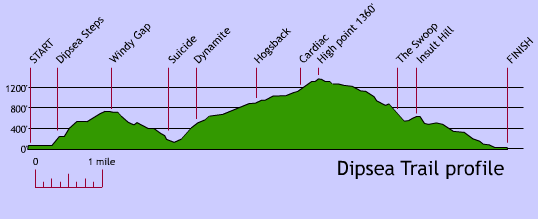
Read more...
Comments and Feedback
Galen Rupp is the Best Ever?
Monday, July 2nd, 2012
Why Galen is going to win a Medal in London!
by Andres Botero Galen Rupp is on the forefront of American distance running, proving that with an easy-looking win in the 10,000 meter run.
Rupp, the American record holder, won in 27:25 and led two other men, Matt Tegenkamp and Dathan Ritzenhein, under the old Trials record of 27:36 held by Meb Keflezighi.
Despite running in driving rain, Rupp looked determined to make his first Olympic team.
The most astounding thing about Rupp's run was how he simply dominated the last mile of the race. He surged three laps from the finish and led comfortably all the way home.
Rupp also went on to beat Bernard Lagat in the 5,000 meters for the first time in his career, running a blazing last lap of 52.54.
With these two accolades, Rupp has made a definitive statement to his international competitors; he isn't afraid to run from the front or from the back.
Not only that, he has the wheels to beat anybody in the final sprint of any race.
This year, Rupp has run three A-Standards in three different events: the 1500 at the Occidental High Performance Meet in May, the 5000 at the Prefontaine Classic in June and the 10,000 at the Trials.
Read more...
Comments and Feedback
60 Years Ago, an Olympic Trifecta of Endurance
Friday, June 29th, 2012
By George Hirsch
Photo: Emil Zatopek won the 5,000 and 10,000 meters and the marathon — all in record times — at the 1952 Olympics in Helsinki, Finland.
I have been fortunate to attend many big international track meets. Each one brought memorable moments, including record performances and crowds of spectators that intermingled in appreciation of the sport.
No experience can compare to my first Olympics, the 1952 Helsinki Games. I had graduated from New Rochelle High School a month earlier and was hungry to see the world while following my favorite track and field athletes.
My vivid memories of the events in Helsinki were aided by a journal I kept and by videos from the Olympic filmmaker Bud Greenspan. My friend Steve Goddard and I booked passage (12 days!) on a tramp steamer for $95. In Helsinki, Steve and I stayed with a local family that charged $2 each a night for a comfortable room, breakfast and any other meals we happened to show up for.
At the opening ceremony, I found myself among the 70,000 spectators on a rainy, chilly day in July. I remember the parade of athletes, nation by nation, walking into the stadium, circling the track, and taking their places on the infield. This was followed by a 21-gun salute, and our breathless anticipation to see who would light the Olympic flame. When Paavo Nurmi, the Flying Finn, who dominated distance running in the 1920s, came striding into the stadium, holding the flame aloft, the crowd erupted in wild appreciation. The athletes on the infield crowded to the track’s edge to get a better look, with one exception: the Soviet Union’s contingent. Dressed in white suits with red ties and scarves, the Soviet athletes stood stiffly at attention. At the height of the cold war, they presented a stark image that served to highlight their differences with the rest of the world.
Read more...
Comments and Feedback
 Emil Zatopek won the 5,000, 10,000 and marathon at the 1952 Olympic Games. He was the first runner to run under 29 minutes for the 10k. He won 38 consecutive 10,000 meter races. George Hirsch wrote this article about Emil Zatopek and that Olympic Games for the New York Times recently. He wanted to share it with us. Thanks George. Really enjoyed reading this... Bob Anderson 6/29/12 11:37 pm
Why Run?
Friday, June 22nd, 2012
Why Run? Because its there…any place, any time.
by Ujena Fit Club Coach Barry Anderson This is a little different approach to the question “Why Run?” that most of us who have run for many years have been asked at some time or another. This approach is to the point of why running is included in many people’s fitness programs, not what motivates them to a healthy lifestyle. From more of the purely practical point of view there are several answers to that seemingly simple little question.
From a financial perspective there is no doubt that running—which includes walking—can usually be done without cost other than the initial investment in a good pair of running shoes. Many cities provide parks and trails that offer alternative running/walking sites to the area streets and roads. Indoor walking in malls across the country offer another alternative during cold or wet weather. Of course, once you learn to enjoy and appreciate running, there will be some on-going costs to replace shoes as the miles covered grows.
Read more...
Comments and Feedback
A Word on Training
Thursday, June 7th, 2012
Are you bored with Running?
by Ujena Fit Club Coach Barry Anderson Yes, believe it or not, it is possible to become bored at times with running. While we have discussed the importance of schedules in earlier articles to assure that we “hit the road” on a regular basis, there can be drawbacks. For many, each day of the week may become repetitive in terms of the type of workout, and the location. As an example, Monday may always be a 4 mile recovery run, Tuesday an interval workout on the track, Wednesday a 6 mile tempo run, Thursday a focus on hills and speed work, and on it goes week after week.
Workout plans such as these are necessary. They will provide the structure that is required to improve consistently as a runner and assure that you are incorporating the correct mix of aerobic, anaerobic, strength, and recovery workouts. What these plans sometimes lack is enough variety to help stave of the boredom that can come with repetition.
Read more...
Comments and Feedback
A word on Running Form
Tuesday, May 22nd, 2012
Keep a Level Head
by Ujena Fit Club Coach Barry Anderson My college coach gave me the simplest, and perhaps most important, concept about running form. He seldom gave advice about running form and likely understood that each of us were built a little different and that a one-way-fits all approach to form is not realistic. A perfect example of what could be called “unorthodox form” was competing just down the road from our school. For those who had the opportunity to see Jim Ryun run, it is surely the side-to-side, rotating, head motion that is remembered—along with his many world middle distance records.
Read more...
Comments and Feedback
 Classic photos with this article. I believe the one with the rather excited official is his finish at the state meet which is still the fastest mile ever run in high school competition...47 years ago this month. Barry Anderson 5/22/12 10:43 am  We had a runner on the West Coast named Mitch Kingery. He ran with his head tilted to one side. At fifteen he ran in he low 2:20's for the marathon. 2:23 if I remember correctly. Richard Stiller 5/24/12 8:13 am
Meb is Ready to Race B2B
Thursday, May 17th, 2012
This is only Meb's second race since making the Olympic Team
As the Zazzle Bay to Breakers kicks off its second century on May 20, 2012, the City can bank on seeing the highest caliber of competition to grace this race in decades. Welcoming back an Olympic silver medalist, the course record holder, and former Boston Marathon champ, this race is sure to be one to go down in the history books.
This year, the Zazzle Bay to Breakers footrace welcomes back 2004 Olympic marathon silver medalist, Meb Keflezighi for the second time at the Cross City Race. Known simply as “Meb” to the running world, as his running performance speaks for itself, ZB2B follows his dominating win at the United States Marathon Olympic Trials. His Olympic Trials victory allowed Meb to make his third Olympic team and immediately catapulted him as a favorite to medal in the London Olympics this summer. Meb is also a member of the Ujena Fit Club.
SPLIT
Read more...
Comments and Feedback
I used to hate running
Thursday, May 3rd, 2012
"While growing up the only running I ever did was from the bullies at school..."
by Steven Richardson I never really like to run as a matter of fact I hated it. While growing up the only running I ever did was from the bullies at school, or my older brothers at the house. I did like to wander out in the wilderness for hours and stop at the spring that was a couple miles from my home to refill on water but never really like to do more than a slow walk unless absolutely necessary.
Going through school I never did any type of sports nor was I even remotely interested in it. My freshmen year of High School I did get the wild notion to try out for track. It only took me one day of conditioning to remind myself that I hated running and it was a waste of time. It wasn’t till my senior year that I finially decided to do something. I tried out for the basketball team but that didn’t work out so the only sport left was track.
Read more...
Comments and Feedback
 Nice article Steven. You have set some very realistic goals for yourself this year...am sure you will make them with your work ethic and positive attitude. Also, thank you for your service. Barry Anderson 5/8/12 9:11 am  Thanks Will only have one shot at the half and that will be in October hopefully I will hit the mark Steven Richardson 5/8/12 9:32 am
Flexibility Can Keep You Injury Free
Thursday, May 3rd, 2012
"It is best to do some light running prior to stretching"
by Coach Barry Anderson Probably the most overlooked part of a workout plan for distance runners is the time spent on stretching and improved flexibility. This concept is probably amplified by the fact that distance running is not seen as an explosive action like sprinting or jumping that are more likely to produce muscle or tendon pulls or tears.
Injuries associated with distance training and racing are more insidious. They will slowly develop as the wear and tear builds over time. Muscles and connective tissue will shorten or become inflamed due to repetitive motion. Eventually these over-use issues will develop as an injury that can prevent running.
Read more...
Comments and Feedback
|
,,,,, |
Double Racing Has Truly Arrived!
Monday, September 22nd, 2014
…And it happened at the second annual San Juan Bautista Double Racing® Festival, Sat., Sept. 20, in a quaint, picturesque, historic central California town near the Monterey coast.
by David Prokop (Editor Best Road Races) Photo: Double 15k top three
Double Racing® is a new sport for runners that some competitors are calling the best running event ever, due to the unique and memorable experience of running it!
At San Juan Bautista on Sat., Sept. 20, the event, the atmosphere and the experience all came together as never before. There were two live bands, an ongoing barbecue presented by one of the main sponsors, Peacock Acres, a not-to-be-believed fruit spread laid out by Driscoll’s, a local fruit company, all of this going on within and contributing to a truly superb atmosphere for a unique competition that seemed perfectly designed for a picturesque little town like San Juan Bautista – and San Juan Bautista, in turn, looking like the picture perfect town to host such an event. An event called the San Juan Bautista Road Racing® Festival no less!
“More people need to see this,” one competitor said enthusiastically. “This is really exciting. I’ve never been part of anything like this!”
Read more...
Comments and Feedback
 I can't wait for our next Double Racing Festival. San Juan Bautista was so much fun on Saturday. Next up Pleasanton Dec 21... Bob Anderson 9/22/14 7:27 pm
Pritz's Honor
Sunday, May 11th, 2014
A world record by Molly Pritz and incredible scenery by Mother Nature highlight the day at the Pacific Grove (Calif.) Double Road Race
By David Prokop, editor Best Road Races
The world’s most unusual race met the world’s most beautiful place, in the opinion of many, and Molly Pritz (photo below), Christine Kennedy and Adam Roach put their own emphatic, dramatic stamp of athletic excellence on the occasion. (Photo above about a half mile out from the start. Adam leading with Molly bringing up the rear. Photos by Catherine Cross)

At the Pacific Grove Double, Sun., May 11 held in Pacific Grove California near Monterey, Molly Pritz, who’s 26, reclaimed the women’s world record in the Double Road Race™ as she recorded an aggregate time of 52:13, running the opening 10K leg in 34:39 and the concluding 5K leg in 17:34 to break the previous world record by 10 seconds.
Read more...
Comments and Feedback
 Click on this link to read an article about the PG Double. Bob Anderson 5/11/14 8:02 pm
Do You Know the Way to San Jose?
Sunday, February 23rd, 2014
Of the many who did, three runners new to the Double Road Race™ winner’s circle were the big winners Sat., Feb. 22 at the San Jose Doubl
By David Prokop,
Editor, BestRoadRaces.com
One of the most exciting things about road racing is that new people often come to the fore so it’s not a matter of the same individuals winning over and over again.
That was the case on Saturday in the San Jose Double, presented by IDT, as three runners who had never won the big prize in the Double before – Chandler Kemp, Tori Tyler and Charlet Gilbert -- emerged as the men’s overall champion, women’s overall champion and best age-graded performer respectively,
Chandler Kemp, 24, who lives in Menlo Park, Calif., ran the 10K in 32:37 and the 5K in 15:45 to win this race in two parts separated by a recovery break in between with an aggregate time of 48:23. It was the first time he had ever run the Double.
Tori Tyler, 26, won the women’s race, running the 10K in 36:45 and the 5K in 18:30 for an aggregate time of 55:60. The first time she had run the Double was in Pleasanton, Calif., exactly two months earlier, when she finished second overall in the women’s race. Second and now first in her first two Doubles – not a bad beginning for her in this exciting, innovative new running event!
Read more...
Comments and Feedback
 I knew the way to San Jose. Great article David. Congrats to all our winners! Bob Anderson 2/23/14 8:30 am  Enjoyed reading your article David! Great connection with the two winners...I can sure relate to Tori, since I'm also an endurance runner. Kat Powell 2/25/14 9:10 pm
KOSKEI LOWERS HIS OWN WORLD RECORD!
Monday, December 23rd, 2013
Kenyan Julius Koskei set a new world record in the second annual Pleasanton Double Road Race
By David Prokop
Julius Koskei (bib 118) is now a perfect two for two in the Double!
He’s run two Doubles, won each one and set a new men’s world record each time out.
Sunday, Dec. 22, at the second annual Pleasanton Double, on a day that dawned frigidly cold but soon warmed dramatically from the benevolent rays of the sun in a cloudless sky, Koskei (pronounced Kos-Kay) broke his own world record in the Double Road Race™ by seven seconds. How fitting that the man who’s emerged as the star of the Double would get his second record on the very same course and at the same place where the Double was born almost exactly a year earlier.
Read more...
Comments and Feedback
 There were six world Double Road Race records set in Pleasanton. Congrats to all our finishers! Bob Anderson 12/23/13 10:56 pm
Sarah Crouch Sets Double World Record
Saturday, September 28th, 2013
Perfect weather at the San Juan Bautista Double Road Race
Altitude-trained and racing-fit Sarah Crouch, 24, of South Lake Tahoe, Calif., set a new women’s world record in the Double Road Race™ on Saturday, Sept. 28 by posting an aggregate time of 52:23:57 in the San Juan Bautista (Calif.) Double.
She ran the opening 10K leg in 35:02 and came back to run 17:21 in the concluding 5K leg to break the previous world record by 14 seconds.
The previous women’s world record in the Double had been 52:38:06, set by Russia’s Liudmila Stepanova in the Indianapolis Double, where she ran 35:26 for the 10K and 17:12 for the 5K.
Read more...
Comments and Feedback
 Congrats to Sarah and Daniel... Bob Anderson 9/28/13 10:19 pm
WORLD RECORDS FALL AGAIN!
Sunday, August 11th, 2013
Koskei and Stepanova Shatter the World Records in the Indy Double.
By Dave Prokop
A new kind of race came to Indianapolis Sunday, August 11 – and as could be expected, it was fast!
Photo: Liudmila during halftime
The Double Road Race™ Indy was the event, Julius Koskei and Liudmila Stepanova provided the dramatics, as they each shattered the existing world records in the Double.
Read more...
Comments and Feedback
 It was a fun and exciting day in Indy, Ind this morning at the Double Road Race. It was so nice meeting many of you... Bob Anderson 8/11/13 5:26 pm
Doubling Up
Wednesday, July 24th, 2013
Who Says there's nothing new under the sun?
by Libby James
On Sunday, July 21, a contingent of Fort Collins runners participated in the Double Road Race-Denver, the first of its kind in Colorado and only the third Double ever held in America.
Photo Above: Libby James with Bob Anderson and David Kibbe also from Ft Collins, Co
So what’s a “double?” And maybe “so what?” Take it from some of us who made the trip to Denver’s City Park. It’s hard. It’s fun. We’d all like to do another one.
Here’s how it works: You run a 10k, pause for an intermission, then run a 5k. Simple enough—until you try it. Bob Anderson, founder of Runner’s World magazine, has done several doubles and says he learns something new every time. The concept of the double is his and he has the innovative spirit, organizational savvy and wherewithal to turn his idea into an event as popular as any 10k or half-marathon.
Read more...
Comments and Feedback
 Thanks Libby for sharing your thoughts about the Double!!!! Bob Anderson 7/24/13 11:50 pm
The Overland Park Double Road Race
Monday, July 1st, 2013
The Pennsylvanians Rule! Tyler McCandless and Moly Pritz break the world records in the OP Double
by David Prokop
On a day when Olympic great Billy Mills and Runner’s World founder Bob Anderson returned to Kansas where it all began for them, two transplanted Pennsylvanians, Tyler McCandless and Molly Pritz, both now living in Boulder, Colo., shattered the world records in winning the men’s and women’s divisions in the Overland Park Double Road Race®.
Tyler McCandless, coming off an impressive 1:03:16 personal best performance he ran in the US Half-Marathon Championships the previous weekend in Duluth, Minn., burned the opening 10K leg of the Double in 30:16, establishing a 76-second lead over the second-place finisher Matt Chesang, former Kansas State University star, and more than a two-minute lead over Matt’s brother, Benson, former University of Kansas standout who’s now an assistant track and cross-country coach at that school.
In the 5K, escorted by the two Kenyans in a gracious display of support to assure Tyler would break the world record, he ran 14:58 for an aggregate time of 45:15.
The previous world record had been 45:34, set by Fernando Cabada of Boulder, Colo., who ran the 10K in 30:31 and the 5K in 15:02 in winning the men’s division at the Pleasanton Double in Pleasanton, Calif., last Dec. 23, the first Double ever run on American soil. Overland Park was only the second Double ever held in America.
Read more...
Comments and Feedback
 There were so many good stories from the Double Roard Race...this is what our editor David Prokop heard. Good job David. Bob Anderson 7/1/13 12:26 pm
Stories From the Double...
Thursday, February 7th, 2013
Tyler McCandless
edited by Dave Prokop, Best Road Races Editor
A native of Northampton, Penn., Tyler McCandless, 26-year-old graduate of Penn State University, now lives in Boulder. Colo., where he’s working towards a Ph.D. in meteorology by doing research at the National Center for Atmospheric Research (NCAR). A very dedicated person, by his own admission, he’s also one of the best distance runners in the country. Winner of the Kauai Marathon the last two years, he finished third overall in the Pleasanton Double Road Race™, behind Fernando Cabada and Daniel Tapia, with an aggregate time of 47:13 – and as you’ll learn as you read on: He did it the hard way; he earned it! At our invitation, Tyler, who is 5’9”, 140 pounds, and has personal bests of 14:21 for the 5K (track), 29:15 for the 10K (also on the track), 45:17 for the 15K, 1:04:59 for the half-marathon, and 2:17:09 for the marathon, submitted the following recap of his experience and race in the Pleasanton Double. (Photo above - Tyler following the pack at the start of the 5k leg)
Read more...
Comments and Feedback
 Good story Tyler...always enjoy reading the inside scoop! Bob Anderson 2/7/13 5:16 pm  Tyler, great story, very informative details--we will try to get you some better weather conditions in Overland Park. Bruce Gilbert 2/9/13 9:14 am  Great read Tyler, thanks for sharing your thoughts... Eldon Regua 2/10/13 7:05 pm
A RESOUNDING SUCCESS!
Thursday, December 27th, 2012
It was history in the making at the Pleasanton Double Road Race™, and a remarkable collection of runners made sure that the event would forever be remembered as the golden beginning of an exciting new sport.
by Dave Prokop, Ujena Fit Club editor
Anyone who wondered how the inaugural Double Road Race™ in American history would play out on the streets of the beautiful city of Pleasanton, Calif., Sunday, Dec. 23, now has the answer: It was an unparalleled success and an unmistakable signpost to the future, despite the intermittent rain and sometime gusty winds that made conditions for the hundreds of runners entered less that ideal.
Considering this was the birth of a new sport, you could even say it was a success of almost moon-landing proportions! For indeed the Double Road Race™ has landed on the American sports scene with a kind of sonic boom in our collective consciousness, and runners all over the country have had their competitive universe expanded and transformed forever.
Read more...
Comments and Feedback
 Be sure to check out David's story on the Double. Lots of World Class times with tons of Christmas spirit. Met many families. The mood in the Recovery Zone was magical...at least for me!!!! Bob Anderson 12/27/12 11:23 pm
MAXIMIZING YOUR RECOVERY, MINIMIZING YOUR MUSCLE STIFFNESS
Monday, December 17th, 2012
What you do during the recovery break of the Double may be just as important as what you do on the roads in the 10K and 5K.
by Dave Prokop
While the Double Road Race™ may be a distance race consisting of two legs, there are really three parts to it, and the third part – the recovery break between the 10K and the 5K – is equally important, if not more so, to one’s ultimate success in the competition.
Certainly, maximizing your recovery and minimizing muscle stiffness during the rest break is the key to doing your best in the Double. We can all agree on that.
But how do you do that? Do you just keep moving around during the rest break? Do you lie or sit down as soon as the 10K is completed and try to conserve every last bit of energy for the 5K to follow? Do you get some sort of physical therapy, such as massage, in the Recovery Zone? Do you do a combination of all of the above? What?
We talked to several respected coaches, elite athletes and therapy experts about the challenge of racing two distances back to back and the best way to approach the recovery period in between. Here’s what they had to say. You pick and choose what you think is best for you.
* * * * *
Dave Smith is the track and cross-country coach at Oklahoma State University in Stillwater, Okla. Named NCAA Coach of the Year in 2009, 2010 and 2012, he has guided his cross-country team to victory in three of the last four NCAA Cross-Country Championships. The man obviously knows what he’s doing.
Read more...
Comments and Feedback
Something Borrowed, Something New
Tuesday, December 4th, 2012
Long a tradition in cycling’s Tour de France, the yellow jersey makes the transition to running Dec. 23 at the Pleasanton Double Road Race™.
by Dave Prokop
It’s been described as one of the most famous pieces of sports clothing in the world.
The yellow jersey finally makes the leap from cycling to running Dec. 23 at the Pleasanton Double Road Race™ when the men’s and women’s winners of the opening 10K leg will wear a yellow jersey in the concluding 5K leg.
Everyone knows that the overall race leader after each stage of the Tour de France wears a yellow jersey going into the next day’s stage. The organizers of the Double, which consists of two legs after all, decided that would not only be an excellent but also a very practical idea for their competition, too.
This is not simply some gimmick or blatant attempt to borrow something so honored and associated with the Tour de France and introduce it as a glamorous new feature in a running competition. Rather, the yellow jersey serves a very practical function and was, in fact, deemed necessary, even imperative, in the effective staging of the Double.
Read more...
Comments and Feedback
THE DOUBLE - Race Strategy Part 4
Friday, November 23rd, 2012
A Runner's Chess Match
By Dave Prokop
In a recent interview, elite marathoner Tyler McCandless (pictured above), winner of the Kuai Marathon the last two years and definitely one of the runners to watch in the Pleasanton Double Road Race™ on Dec. 23, was asked what he thinks are the keys to doing well in the Double.
The Ph.D. candidate in meteorology replied, “Mental toughness, racing instinct, physical fitness and an intelligent game plan. I think if you have all four of those, you’re all set to accomplish your reasonable goal in the Double.”
Helping participants develop an intelligent game plan has been the underlying purpose of this tactical analysis of the Double. In Part Four we’ll look at another 10 possible strategies you can use in the competition.
Next week in Part Five, the concluding section of this series, we’ll finish by looking at a final 10 strategies, which will bring the total discussed in this series to an even 50!
The very fact that there are 50 strategies or more you can use in the Double illustrates how varied, subtle and complex this competition is or can be tactically.
30. THE ALWAYS-GO-FOR-THE-GUTSY-MOVE STRATEGY -- This is the other side of the coin to the example given above. If you can imagine yourself being the runner who was victimized by the athlete who suddenly jumped the field and got a big lead when you weren't paying attention, you also can imagine yourself as that other person who had the initiative and guts to make that move. In a tactically oriented competition like the Double, willing to make the gutsy move can pay big dividends, as in the example cited above.
Read more...
Comments and Feedback
The Double - Race Strategy Part 2
Tuesday, October 30th, 2012
A ROAD RUNNER’S CHESS MATCH
by Dave Prokop (Second of a four part article)
If we whetted your appetite with the first 10 strategies offered last week in Part One of this tactical analysis of the Double Road Race™, here are another 10 possible strategies for you to consider (and, dare we say it, digest?). Next week – in Part Three – we’ll list another 10 strategies, followed the week after that – in Part Four – by still another 10!
Well, we did warn you that there are almost an endless number of strategy variations possible in the Double.
11. THE KEEPING-UP-WITH-THE-JONES'S STRATEGY -- As the Double becomes established as a competition and athletes become more familiar with the performance standards and who has done what, competitors will be better able to gear themselves to running specific times for the 10K and 5K legs. If you know, for example, that a fellow runner in another Double did 32:15 and 15:45 for the 10K and 5K respectively and you feel that you're better than that individual, clearly you'd be shooting to run at least those times, if not faster.

The top three leaders at the recent Cabo Double Oct 27. Javier (bib 12) ran the 10th best time ever posting 53:58 (36:04 10k and 17:54 5k legs)
Read more...
Comments and Feedback
 Some more good Double reading...thanks Dave and I can not wait to read your next 10 strategies... Bob Anderson 10/30/12 10:19 pm
Brith of a New Sport?
Monday, October 15th, 2012
A Unique New Running Competition called the Double
by Dave Prokop History will be made Dec. 23 in Pleasanton, Calif., with the first-ever staging on American soil of an unique new running competition called the Double (short for Double Road Race).
Lead Photo: start of the 5k leg of the sixth Double held in Mexico. Puerto Vallarta June 2012...the world men's and women's records were broken.
A distance race consisting of two legs -- an opening 10-kilometer leg, followed by a five-kilometer leg, with a break in between -- the Double is the brainchild of running visionary and innovator Bob Anderson, founder of Runner's World magazine, which he published for 18 years, and an avid runner for 50 years.
“It's not two races in one day,” says Anderson in describing his creation, “It's one race with two legs. This is the only running event with a halftime.” Except that in the Double, where the two legs are 10K and 5K respectively, the break should more accurately be termed “two thirds time” rather than “halftime.” The 5k leg starts 100 minutes after the start of the 10k. (However, runners will have official times for both legs and these can be recorded as two races.)
Read more...
Comments and Feedback
 Hope you are enjoying Dave Prokop's writing as much as I am, "the Double has been described as a road running chess match in shoes, shorts and a singlet." Bob Anderson 10/17/12 9:06 am
KENNEDY SHOOTS FOR WORLD RECORD IN CHICAGO
Friday, October 5th, 2012
The course is fast, Christine Kennedy is at the peak of fitness -- Will the women's marathon record for the 55-59 age group fall this Sunday in Chicago
by David Prokop Back in 1989 Christine Kennedy ran the Berlin Marathon is 2:35:05, missing the A Standard (2:35:00) to qualify for the Irish Olympic team by a mere five seconds.
That frustration turned out to be a blessing in disguise. Because while none of her Irish distance running contemporaries who made that Olympic team, thus fulfilling their dreams, are still racing today, Christine Kennedy is not only going strong at age 57 but is truly one of the most amazing runners in the world, even if you don't take age into consideration!
“It was probably a good thing I didn't make that team,” Christine says, “because I don think I'd be running so seriously now if I had. When you go to the Olympics, you've met your goal as an athlete, and I don't think I've met my goal.”
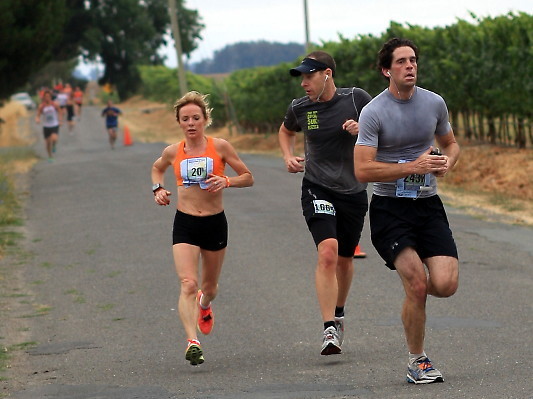
Photo: Christine ran 1:25:10 at the Napa to Sonoma Half Marathon earlier this year.
This Sunday, in the Chicago Marathon, the small of stature, big of heart runner (she's only 5'1”, 98 pounds) hopes to meet one of her most important goals when she shoots for the world marathon record in the women's 55-59 age group, and she's not shy in voicing her intentions.
Read more...
Comments and Feedback
 Good luck Christine...thanks for taking the time to speak with our editor Dave Prokop yesterday! Bob Anderson 10/5/12 1:42 pm  I wish you all the best Christine! The weather should be perfect to go after the record! You are one tough gal, go gettem! Dick Beardsley :-) Dick Beardsley 10/6/12 4:38 am
Kenyan Distance Runners under scrutiny in doping inquiry
Tuesday, October 2nd, 2012
An investigation into allegations of doping by Kenyan runners have been launched
by Nick Hoult (The Telegraph) The Kenyan police, Athletics Kenya and the World Anti-Doping Agency are probing accusations that doctors in Kenya have injected runners with banned substances in return for a portion of the athletes’ winnings.
Photo: Kenya's David Rudisha amazed the world at the Olympics in London.
The allegations surfaced over the weekend when a German journalist, Hajo Seppelt, revealed he had spent months in Kenya posing as a sports agent in order to gather evidence. He alleged doping is rife among Kenya’s runners and the foreign athletes who train in the Rift Valley, a popular base due to its altitude.
“We are working with the Kenya Police and World Anti-Doping Agency to have the culprits arrested for that criminal act,” said Isaiah Kiplagat, the chairman of Athletics Kenya. “Kenyans are usually under a microscope for the good performance internationally and for credibility, we have to ensure that anti-doping measures are in place to avoid being suspected.” Kiplagat said he expects some doctors to be arrested before December.
Read more...
Comments and Feedback
 I really hope this is not happening... Bob Anderson 10/2/12 8:45 am
Final Olympic Thoughts
Thursday, September 6th, 2012
Favorite Olympic Moment
by Barry Anderson Now that nearly a month has passed since the London 2012 Olympics, there is still one memory that stands beyond all others as a favorite moment of the games. There is also one race that ranked above all others in terms of quality of performance…and may be one of the best races ever run.
The men’s 800 meter final was, at least for me, an unexpected display of middle distance excellence. What was expected was that David Rudisha would win the gold medal. This Kenyan was the world record holder entering the competition at 1:41.01 and had the leading time in the world going into the Olympic competition with an impressive 1:41.54 in July. Rudisha basically lead from the gun with a 49 plus opening 400 and became the first to ever run a sub 1:41 with a new world record of 1:40.91. The most amazing thing about the race was what was happening with the other seven finalists.
Read more...
Comments and Feedback
Falmouth Road Race is a Classic
Monday, August 6th, 2012
Celebrating 40 years
Falmouth, Massachusetts will be host to a who’s who of distance running, past and present, with the celebration of the 40th running of the New Balance Falmouth Road Race. 2011 champion Lucas Rotich is back to defend his title with the hottest man on the circuit, Alan Kiprono, nipping at his heels. While 2010 women’s champion, Wude Ayalew Yimer is back to challenge the field, the best women’s battle may be in the masters division between past champions Catherine Ndereba and Colleen De Reuck.
The New Balance Falmouth Road Race will take place on Sunday, August 12, 2012, when 12,800 participants will line up on the newly dedicated “Tommy Leonard Start Line” in front of The Captain Kidd in Woods Hole, MA. This will be Bob Anderson (Ujena Fit Club director) 32nd race of the year of the 50 he is running in 2012.
Rotich, 22, from Kenya has a 26:43.98 time from the Brussels Diamond League Meet last year as well as a second place finish at the TD Bank Beach to Beacon race last year. On his heels will be the 2012 Dick’s Sporting Goods Bolder Boulder champion, Alan Kiprono, 22, of Kenya with a personal best of 27:42 for the 10K. Kiprono is on a hot streak with wins at Lilac Bloomsday Run and The Bellin Run as well. This is his Falmouth debut. Ed Muge, 29, of Kenya was third at Falmouth in 2011, and is a two-time TD Bank Beach to Beacon champion. Muge will be a factor along with American Chris Solinsky, 27, the former American 10,000 meters record holder with a time of 26:59.60. Tim Nelson, 28, a fellow American, is also expected to be in the lead pack. He has a 27:28.19 10,000 meter time and was a member of the 2009 World Championship team in Berlin.
Read more...
Comments and Feedback
2012 London Olympics
Friday, July 27th, 2012
Olympics a showcase for Runners
by Bernice Torregrossa Tonight’s opening ceremonies for the 2012 Summer Olympics kick off more than two weeks of exciting competition, and runners and fans of running will have more opportunities to see long-distance running on television than ever before.
While there will be ample coverage of running events, fans of long-distance running will have to wait another week or two to see their favorite events. The men’s marathon will be one of the last events of the Games, held on Aug. 12, the same day as the closing ceremonies, and the 5-kilometer races are scheduled for that weekend as well.
The first long-distance event begins Aug. 3, when the finals of the women’s 10-kilometer race takes to the track. Many local runners participate in 10K races, a popular distance throughout the year, but those 10K events are held on the road. The Olympic 10K takes place on the track, with runners making 25 laps around the oval.
Read more...
Comments and Feedback
 Can Galen Rupp pull off an upset in the 10000 Aug 4th? Anything can happen at the Olympics. Billy Mills did it...Go Galen!!!! Bob Anderson 7/27/12 10:12 am
An Ice Cube a Day Can Keep the Shin Splints Away
Tuesday, July 24th, 2012
A Proactive Approach
by Barry Anderson Shin splints are probably the most common injury experienced by distance runners. They can become frustrating, debilitating, and can lead to the need for total rest from running for recovery.
As you can guess, shin splints are a pain that is located toward the front or side of the larger bone (tibia) in the lower leg. The pain will often feel like a burning sensation or at times a dull ache. The cause of this pain is mainly due to the inflammation of the sheath that surrounds the tibia. In general, shin splints are classified as an “over-use injury” and are often seen when just beginning a running program or stepping up the intensity, duration, or frequency of workouts.
Read more...
Comments and Feedback
Paavo Nurmi
Friday, July 13th, 2012
Six Days In July 1924
by Barry Anderson The recent article by George Hirsch on Emil Zatopek and his triple gold medal performance at the 1952 Olympic Games in Helsinki provided some wonderful insight into this great distance runner. To be able to witness such excellence in person obviously has etched a forever lasting memory for George Hirsch of Zatopek as a person and a runner. In keeping with the Olympic theme, we will be presenting some additional articles on distance running greats and their accomplishments in Olympic competition.
Prior to Zatopek’s trifecta in 1952, he began his road to Olympic greatness with two outstanding performances in the London games in 1948. His winning of the 10,000 and silver medal in the 5,000 both foreshadowed his record breaking performances to come in 1952 and, signaled the end of more than three decades of distance running dominance by a single country that has never to date been matched. In the six Olympic games held from 1912—when the 10,000 and 5,000 were added—through 1936, one relatively small European country won nearly half (48.1%) of the medals available in these two distance track events and the marathon. Finland was so dominating during this time frame that even with the emergence of the African nations beginning in Rome in 1960 the Finnish still today have won more Olympic medals in these three events than any other nation.
Read more...
Comments and Feedback
 Paavo Nurmi was such an amazing distance runner...really enjoy your article Barry... Bob Anderson 7/13/12 4:08 pm
Two-A-Day Workouts
Monday, July 2nd, 2012
Help reduce stress-type injuries
by Barry Anderson, Ujena Fit Club Coach One of the best ways to add to your mileage base just may be to add a second workout to your day. During the endurance base building phase of a distance running training program, the primary focus on workouts is increasing weekly mileage and developing aerobic capacity. Most coaches and exercise science specialists agree that only a 10%-15% increase in total mileage run per week should be added to help avoid overuse-type injuries.
For many runners, this weekly mileage consists of 2-3 long runs at what is often called “steady state” running pace. For those who use heart monitors during their runs, a steady state run would be where the heart rate is maintained in the 65%-70% of maximum heart rate. For those who run by feel, a steady state run should produce a sense of effort during the run but not exhaustion when completed. On the other days of the week, shorter and easier runs should be completed.
During your gradual increase in weekly mileage you may want to consider the addition of a second daily workout to add to your mileage. If you primarily workout in the afternoon or evening, start with an additional morning run twice per week. Then, continue to gradually increase your weekly mileage by adding more morning runs.
Read more...
Comments and Feedback
Rupp wins 5000m in Eugene
Thursday, June 28th, 2012
Galen Rupp wins both the 10,000 and 5,000 at the Olympic Trials
(AP) EUGENE, Ore. -- Never in his wildest imagination did Galen Rupp ever think he would outkick one of the best in the business.
He did just that, surpassing Bernard Lagat near the finish line in the 5,000-meter final at the Olympic track trials on Thursday night.
And never did Rupp think he would be mentioned in the same breath as the late Steve Prefontaine, a legend around these parts.
He accomplished that, too, breaking Pre's nearly 40-year-old meet record when he burst across the line in 13 minutes, 22.67 seconds, eclipsing the mark by a scant 0.13 seconds.
Quite a night for the former Oregon Duck distance runner. Quite a trials, too, as Rupp also won the 10,000 last week.
"I couldn't be more happy with how the meet went for me here," said Rupp, who's planning to run in both events at the London Games. "I knew this was going to be the hard one."
Shortly before the race, marathoner Abdi Abdirahman sent out a tweet that simply read: "The boss of America distance running is on the track."
Read more...
Comments and Feedback
US Olympic Trials Schedule
Thursday, June 21st, 2012
Eight Days of Action Gets Underway in Eugene this Friday
The running events at the U.S. Olympic Track and Field Trials get underway this Friday, June 22, at the University of Oregon’s Hayward Field. Below is a time schedule for the races (not field events).
 A total of 12 hours of live track and field coverage will be a part of a record 67.5 hours of total Olympic Team Trials coverage by NBC in 2012. Viewing information is included below and on nbcolympics.com. A total of 12 hours of live track and field coverage will be a part of a record 67.5 hours of total Olympic Team Trials coverage by NBC in 2012. Viewing information is included below and on nbcolympics.com.
Note: All times listed below are Pacific Time unless otherwise noted.
Friday, June 22 —
TV COVERAGE: 9-11 PM EST on NBCSN
3:10 PM Men’s 400m First Round
3:35 PM Women’s 400m First Round
5:00 PM Women’s 800m First Round
5:20 PM Men’s 800m First Round
5:40 PM Women’s 100m Hurdles First Round
6:00 PM Women’s 100m Qualifying
6:45 PM Men’s 10,000m Final
7:20 PM Women’s 10,000m Final
Saturday, June 23 –
TV COVERAGE: 8-9 PM EST/PST on NBC
3:15 PM Women’s 110m Hurdles Semifinals
3:40 PM Women’s 100m Semifinals
4:00 PM Men’s 100m Qualifying
4:30 PM Women’s 800m Semifinals
4:45 PM Men’s 800m Semifinals
5:00 PM Men’s 400m Semifinals
5:15 PM Women’s 400m Semifinals
5:45 PM Women’s 100m Hurdles Finals
5:52 PM Women’s 100m Finals
Read more...
Comments and Feedback
A word on Goals
Tuesday, May 29th, 2012
Strategies for Setting Realistic Goals
by Ujena Fit Club Coach Barry Anderson Goals can play a vital role in many aspects of our lives—and running and fitness are no exception. Setting unrealistic goals, however, can become demoralizing and lead to such frustration that many will eventually give up entirely. It is also possible to set goals that are not challenging enough which will stifle progress.
Goal setting does not necessarily have to do with performances in races, or efforts to reach personal best times for various distances. Though those are excellent types of goals, many will benefit from starting their goal setting based on other criteria. For instance, someone just beginning a running or exercise program may focus more on weekly mileage or number of workout days per week. It is also helpful to write your goals down either in your training log or somewhere that you can review them on a regular basis.
Read more...
Comments and Feedback
A word on Running Shoes
Tuesday, May 22nd, 2012
New Shoes Can Give You a Psychological Boost
by Ujena Fit Club Coach Barry Anderson By far, the most important piece of equipment for a runner is a good pair of shoes that are designed for running. That seems so obvious but I am often surprised to see runners on the trails and roads around town in a variety of tennis, basketball, or other types of sports shoes that are going to eventually be a problem. Many running injuries are related to improper foot wear or shoes that have been worn past the point of providing proper support and foot strike placement. With all of the excellent brands of shoes built specifically for running today, and the advent of retailers who can fit shoes more precisely to your body size and running form, there is every opportunity for you to use shoes the will work well for you. Just make sure to frequently check for wear patterns on the soles and replace when needed.
Read more...
Comments and Feedback
 Your defiently on track with this article. Seems everytime I get a new pair of shoes I get a PB time in some distance or another. I am still experamenting with shoes at the time and have found my racing shoes but still playing around with diffrent trainers. Steven Richardson 5/30/12 5:49 am  I am doing most of my training in racing shoes. I try to not wear the same pair of shoes two days in a row. I am rotating about six pairs now... Bob Anderson 6/8/12 12:19 am  I don't have enough space in my house for six pairs of shoes. :) Richard Stiller 6/8/12 7:49 am  At your low weight (145) and weekly mileage Bob, I would think that training shoes would work fine. If you were pounding out 100 mile weeks that would be a different story. Do you have a pair or two that you save just for races? Barry Anderson 6/8/12 10:44 am  I do have one pair only for racing and adidas no longer makes it... Bob Anderson 6/8/12 12:31 pm  I like trainers because they are alittle heavier then my racing shoes. Seems to help with my build up for the race. Then on race day I ware lighter shoes and its seems like I'm running on air. Steven Richardson 6/8/12 8:50 pm  I found an old pair of New Balance 320's from the 1970's. One of my favorite trainers. But now, looking at them, it is hard to believe I ever could have run in them. Richard Stiller 6/14/12 7:17 am  I agree with you Rich...I too can not I believed I ran any distance in some of my old shoes... Bob Anderson 6/14/12 11:03 am  For a year in college we got to try out some Lydiard shoes. He spent several days in Manhattan for some reason and I think he brought a bunch for us to try out. Liked them a lot but they wore out fast...of course that was at a time when we were doing 150 a week for months in a row. Not real sure how long they were made. Barry Anderson 6/14/12 12:10 pm  I remember my 1st pair of running shoes were Nike Waffle Trainers, blue with yellow swoosh. Remember those? Bill Dunn 6/14/12 2:57 pm  I remember those well. The Lydiards too. I remember when Nike started to go hog wild on making the soles wider and wider. Sort of like the tail fins on 1957 caddies. I had one pair and the inside of the sole would slash across the inside of my other leg. After that I stuck with NB. Richard Stiller 6/14/12 4:14 pm  My first pair of running shoes were converse...they were so bad...then I got a pair of adidas that were just as bad...Lydiard, Nike Waffle Trainers, the original New Balance, etc. Now it is adidas in the bright colors that's working for me... Bob Anderson 6/15/12 6:45 am  I had coverse also Bob...think they were black with white stripes...very narrow soles. Barry Anderson 6/15/12 8:44 am  I remember racing in Tiger Jayhawks way back when. Not much sole thickness. Bill Dunn 6/15/12 3:37 pm
A word on Downhill Training
Sunday, May 13th, 2012
Downhill Training Can Improve Speed - Be Careful
by Coach Barry Anderson When properly executed and planned into a training program, running downhill can improve your speed. In fact, several track and field facilities across theUnited Stateshave included 100 meter or longer incline/decline lanes for training in addition to their 400 meter track and throwing areas. Be careful though—improper use of downhill training can cause injury as the stress on the legs and joints does increase based upon the grade of the decline, and running speed and form.
Read more...
Comments and Feedback
 I just like running downhill and I know it helps my leg turnover...however it can be tough on the quads... Bob Anderson 5/15/12 5:13 pm  You do have to use some caution with downhill training. The most common mistake is too steep of a grade combined with a hard surface (road). Very gradual grassy slopes are great if you can find one that is smooth...like a golf course. Of course, that can cause an entirely different problem since runners are often not welcomed on golf courses. Barry Anderson 5/21/12 10:18 am
The Variables; Duration, Frequency, Intensity
Thursday, May 3rd, 2012
"Workouts like interval training or fartlek runs involve all three variables"
by Coach Barry Anderson As you plan your training program and progress toward your overall goals keep these three variables in mind—Duration, Frequency, and Intensity. These variables can apply to any type of workout (easy run, interval, etc.) or overall training plan to help assure your progression to higher levels of fitness.
Duration can be measured in terms of distance or time. Particularly for the beginner, time may be an easier way to measure the duration component since the majority of runners use roads and trails that may not have known distance markings. At some point it will be beneficial to also do runs based on distance if you include entering organized races as a part of your running goals. Knowing that you can run 3 miles will help give you confidence in your first 5k race.
Read more...
Comments and Feedback
It was Hot in Boston for the marathon
Wednesday, April 18th, 2012
Christine Kennedy posted the best age-graded performance
by Bob Anderson It was a hot day to run a marathon. Tempertures at this year's Boston Marathon (April 16) rose to 89 degrees during the event.
Race winner Wesley Korir didn't ignore that factor, employing strategy rather than speed to win the 116th annual race. Korir, a resident of Louisville, Ky., who is seeking U.S. citizenship, said he likes running in the heat because it allows him to think more about strategy than speed. That outlook may have helped him when the lead pack picked up its pace and left him behind before Heartbreak Hill. He said as much after the race:
Read more...
Comments and Feedback
|
 Emil Zatopek won the 5,000, 10,000 and marathon at the 1952 Olympic Games. He was the first runner to run under 29 minutes for the 10k. He won 38 consecutive 10,000 meter races. George Hirsch wrote this article about Emil Zatopek and that Olympic Games for the New York Times recently. He wanted to share it with us. Thanks George. Really enjoyed reading this...
Emil Zatopek won the 5,000, 10,000 and marathon at the 1952 Olympic Games. He was the first runner to run under 29 minutes for the 10k. He won 38 consecutive 10,000 meter races. George Hirsch wrote this article about Emil Zatopek and that Olympic Games for the New York Times recently. He wanted to share it with us. Thanks George. Really enjoyed reading this...








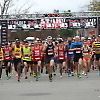

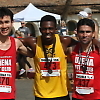



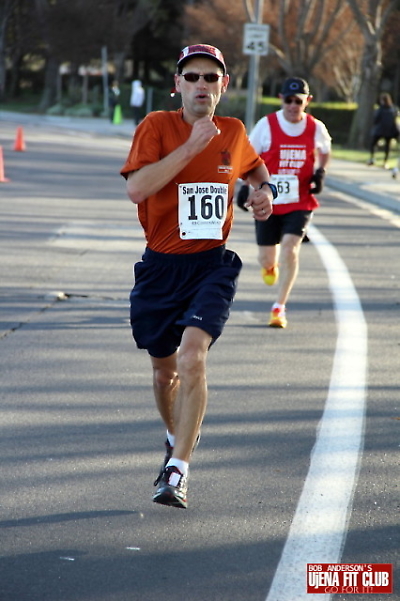
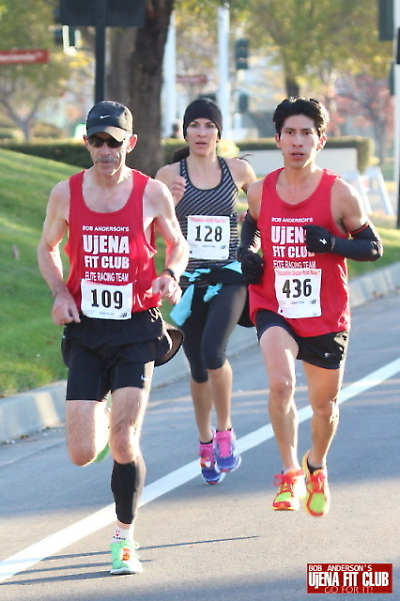
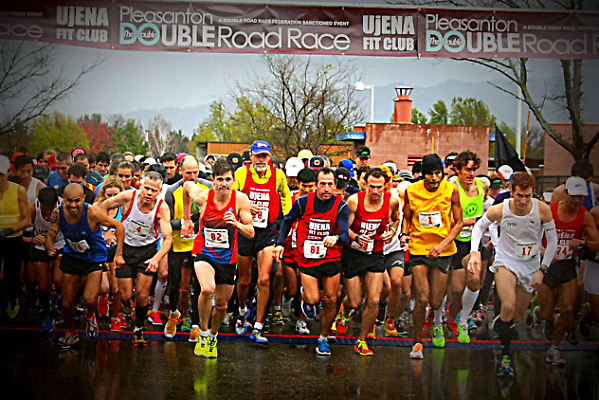
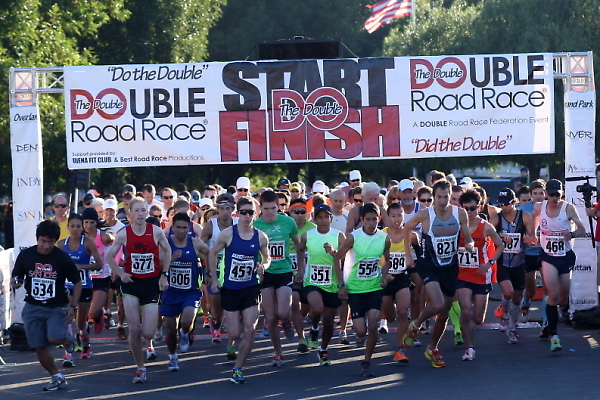
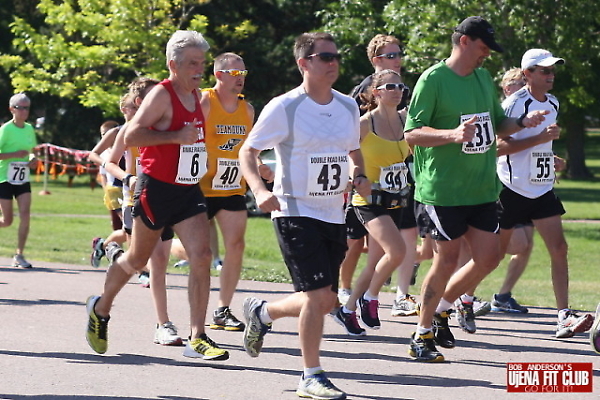
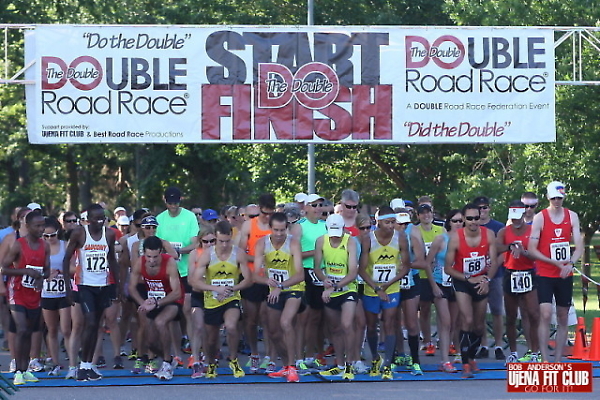








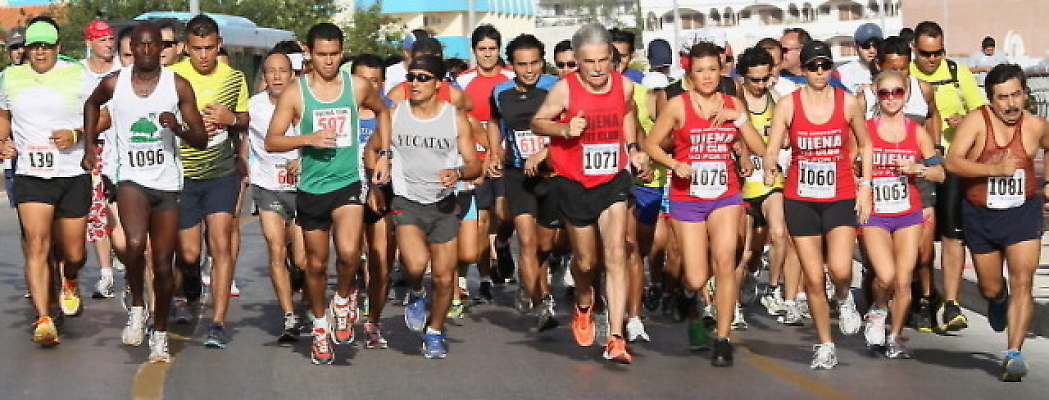

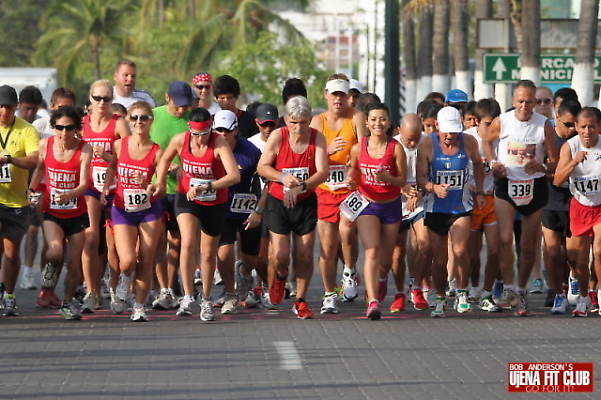
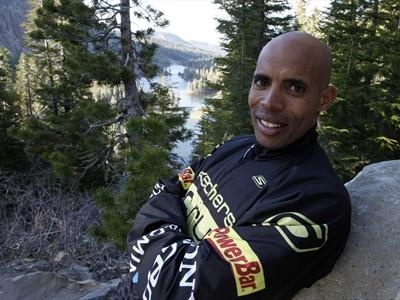





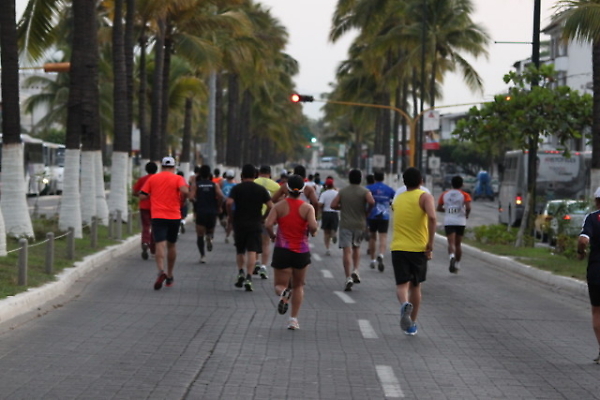










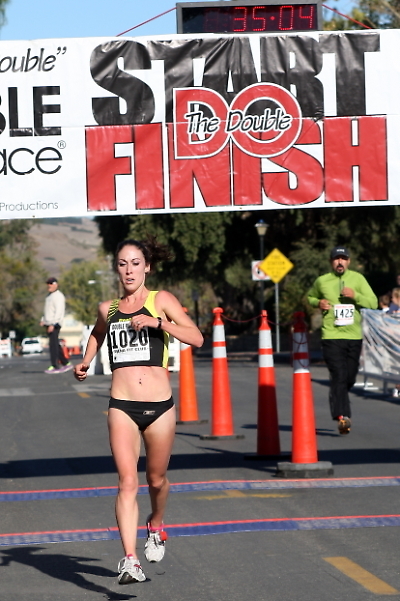

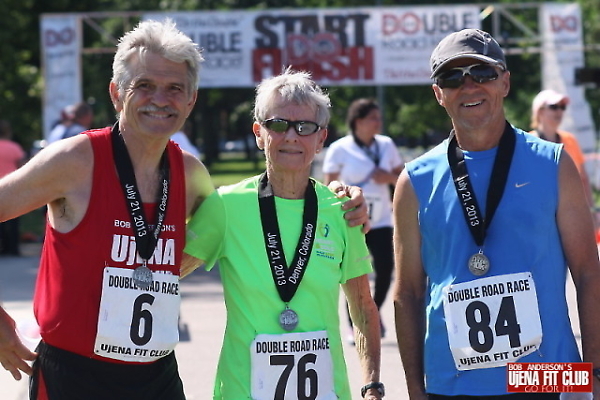
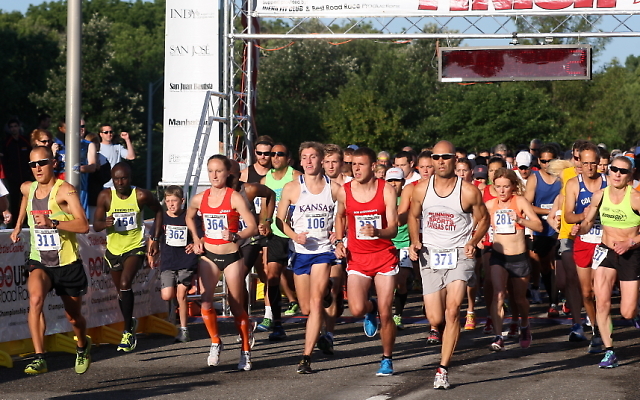
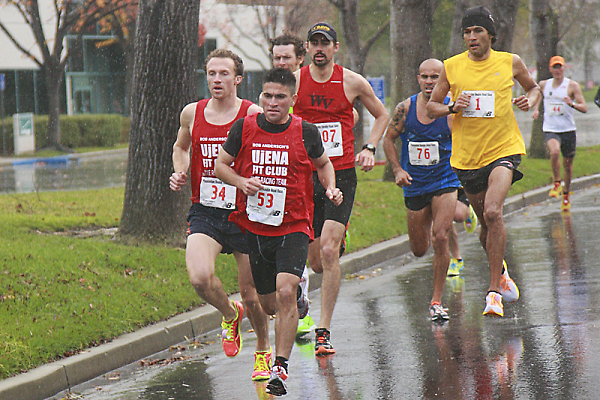









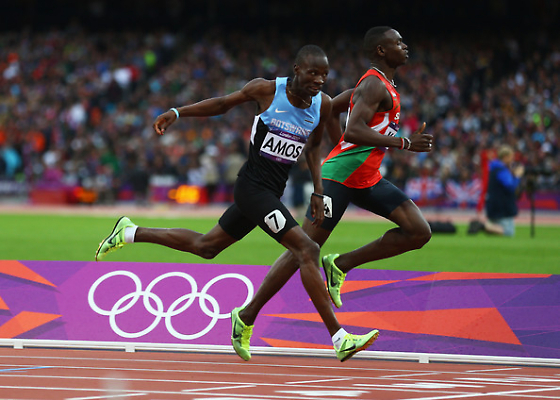

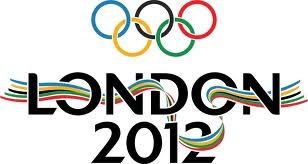


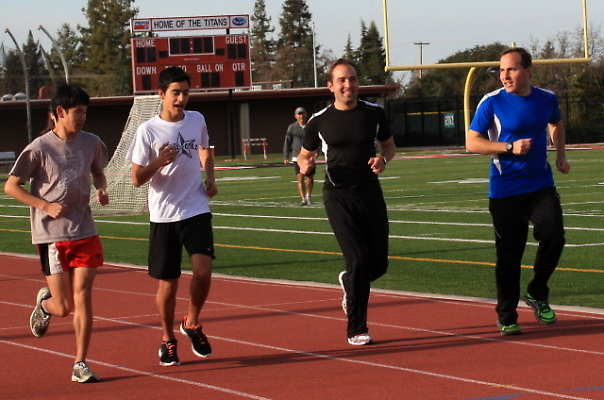
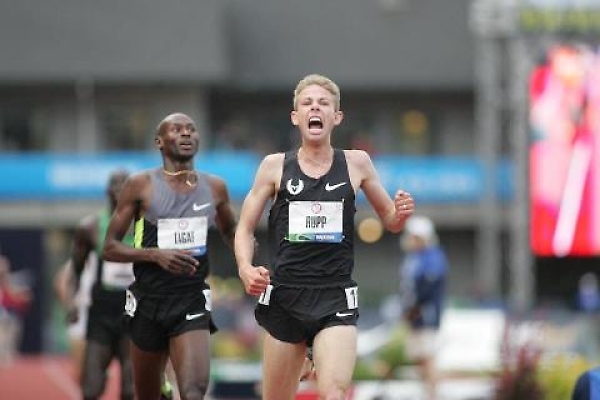

 A total of 12 hours of live track and field coverage will be a part of a record 67.5 hours of total Olympic Team Trials coverage by NBC in 2012. Viewing information is included below and on
A total of 12 hours of live track and field coverage will be a part of a record 67.5 hours of total Olympic Team Trials coverage by NBC in 2012. Viewing information is included below and on 






